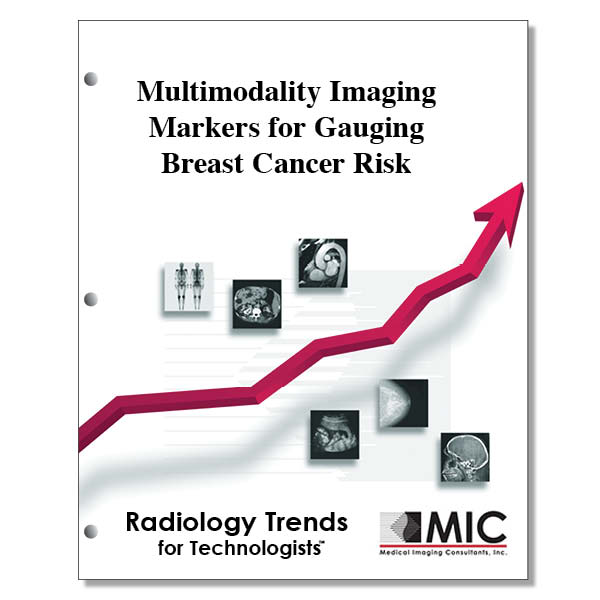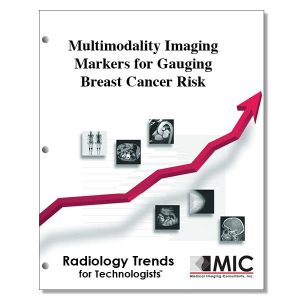

Multimodality Imaging Markers for Gauging Breast Cancer Risk
Beyond breast density, a range of imaging markers associated with breast cancer risk is described, with the goal of enabling personalized screening strategies.
Course ID: Q00795 Category: Radiology Trends for Technologists Modalities: Breast Sonography, Mammography, MRI, Radiation Therapy, RRA2.5 |
Satisfaction Guarantee |
$29.00
- Targeted CE
- Outline
- Objectives
Targeted CE per ARRT’s Discipline, Category, and Subcategory classification:
[Note: Discipline-specific Targeted CE credits may be less than the total Category A credits approved for this course.]
Breast Sonography: 2.50
Patient Care: 2.00
Patient Interactions and Management: 2.00
Procedures: 0.50
Anatomy and Physiology: 0.50
Mammography: 2.50
Patient Care: 0.75
Patient Interactions and Management: 0.75
Procedures: 1.75
Anatomy, Physiology, and Pathology: 0.50
Mammographic Positioning, Special Needs, and Imaging Procedures: 1.25
Magnetic Resonance Imaging: 1.00
Procedures: 1.00
Body: 1.00
Registered Radiologist Assistant: 2.50
Procedures: 2.50
Thoracic Section: 2.50
Sonography: 1.00
Procedures: 1.00
Superficial Structures and Other Sonographic Procedures: 1.00
Radiation Therapy: 1.00
Patient Care: 1.00
Patient and Medical Record Management: 1.00
Outline
- Introduction
- DM and DBT
- Mammographic Density
- Augmenting Epidemiologically Based Models with Breast Density
- Assessing Breast Texture with Radiomic Features
- Deep Learning in Breast Cancer Risk Assessment
- Digital Breast Tomosythesis
- Breast US
- Tissue Composition of Breast US: BI-RADS Classification
- Internal Echogenicity Patterns of Fibroglandular Tissue
- Internal Echogenicity Patterns and Breast Cancer Risk
- Future Directions for Breast Cancer Risk Assessment Using Breast US
- Breast MRI
- MRI Overview
- Biologic Underpinnings
- BPE and Breast Cancer Risk
- BPE in Women with Elevated Risk
- BPE in Women with Average Risk
- Future directions in MRI
- Future Directions and Clinical Implementation
- Conclusion
Objectives
Upon completion of this course, students will:
- describe what type of breast tissue places individuals at a higher risk for breast cancer
- review the meaning of fibroglandular as it pertains to breast density
- describe the appearance of fibroglandular tissue as it appears on two-dimensional digital mammography and digital breast tomosynthesis
- list factors that tend to decrease breast density
- state the prevalence of mammographically dense breasts in women aged 40-74 years in the United States
- recall the breast anatomy where breast cancer most frequently arises
- distinguish between how breast imaging modalities demonstrate breast cancer
- list the early works in mammography that were used to assess breast cancer risk
- recall what agency developed the BIRADS system
- interpret categories of the BI-RADS assessment of mammographic breast density
- recall the method that has been utilized to standardize BI-RADS risk assessment
- explain the difference between BI-RADS 4th and 5th edition as it relates to breast tissue density
- state the software utilized to calculate area-based percent of breast density
- state the number U.S. Food and Drug Administration–approved density assessment methods for DM, DBT, and synthetic mammography using artificial intelligence
- choose the study that found that volumetric percent density at DM offered stronger association with breast cancer risk than total dense volume
- list the risk assessment models that include breast density in risk calculation
- explain how parenchymal complexity can be assessed
- list the way in which parenchymal complexity can be visualized at digital mammography
- choose the study that created a lattice of windows for radiomic feature extraction
- choose the study that used a convolutional neural network–based pixel wise risk model to identify women at high-risk by analyzing negative mammograms from at least 2 years prior to cancer
- choose the study that developed the mammography-based deep learning model known as Mirai
- explain what type of image digital breast tomosynthesis uses for reconstruction
- choose the study that compared DM, DBT, and SM in terms of density assessment
- note how many images are performed at digital breast tomosynthesis examinations
- explain breast tissue composition at breast ultrasound according to BI-RADS 5th edition
- note how dense breast tissue on mammograms is categorized according to BI-RADS 5th edition
- list the four types of sonographic parenchymal patterns classified by Hou et al
- describe how sonographic glandular tissue component classification can be estimated more easily at automated breast ultrasound
- state the primary anatomic source of breast cancer
- recall the most sensitive imaging modality for the detection of breast cancer
- list the qualitatively assessed BPE levels as demonstrated at MRI
